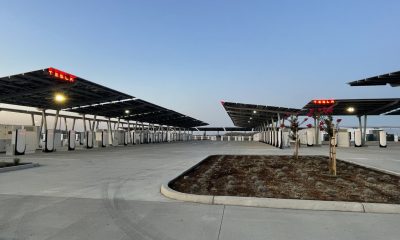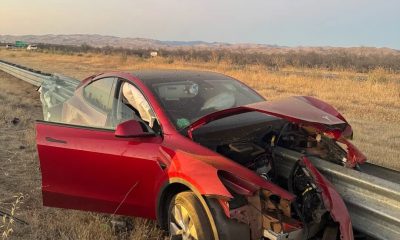News
Details behind Model X owner’s $5M+ class action lawsuit against Tesla
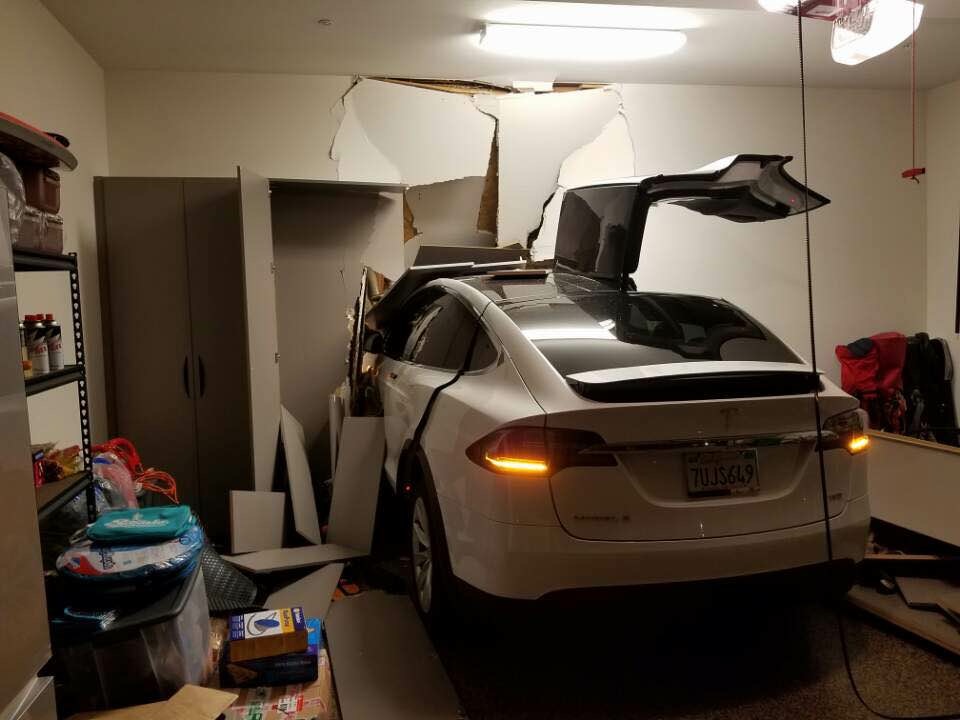
Following our report that a Model X owner has filed a class action law suit against Tesla, claiming a widespread defect in the vehicle’s onboard software causes sudden unattended acceleration (SUA), new details behind the suit have been obtained by Teslarati that shows a legal team aggressively targeting the core component to the Silicon Valley-based electric car maker’s fleet of vehicles.
The class action filed in federal district court claims Ji Chang Son – Korean star residing in Orange County, Calif. – crashed through his garage and into the living room of his home after his Tesla Model X accelerated suddenly and without warning on September 10, 2016, approximately one month after Mr. Son took delivery of the electric SUV. The suit claims that “Tesla has failed to properly disclose, explain, fix, or program safeguards to correct the underlying problem of unintended acceleration”, adding that “over sixteen thousand Model X owners with vehicles that could potentially accelerate out of control.
Son’s attorneys gave the court a full account of the development of the Model X, focusing on the company’s claim that the Model X is “the safest, fastest and most capable sport utility vehicle in history.” On the contrary, according to Son’s attorneys. They allege the Model X has a safety defect that permits the car to accelerate at full speed directly into solid objects, such as the exterior wall of Son’s home. In particular, they point out that 8 written complaints have already been filed with the National Highway Transportation Safety Administration from other Model X owners who report similar occurrences while driving their cars.
The lawsuit reads,
“Irrespective of whether the SUA events in the Model X are caused by mechanical issues with the accelerator pedal, an unknown failure in the electronic motor control system, a failure in other aspects of the electrical, mechanical, or computer systems, or some instances of pedal misapplication, the Model X is defective and unsafe. Tesla’s lack of response to this phenomenon is even more confounding when the vehicle is already equipped with the hardware necessary for the vehicle’s computer to be able to intercede to prevent unintended acceleration into fixed objects such as walls, fences, and buildings.
Despite repeated instances of Model X drivers reporting uncommanded full power acceleration while parking, Tesla has failed to develop and implement computer algorithms that would eliminate the danger of full power acceleration into fixed objects.This failure to provide a programming fix is especially confounding for a vehicle that knows when it is located at the driver’s home and is being parked in the garage, yet carries out an instruction, regardless of whether through an error by the vehicle control systems or by driver pedal misapplication, to accelerate at full power into the garage wall.
Further, not only has Tesla failed to fix the problems, it has chosen instead to follow in the footsteps of other automobile manufacturers and simply blame the driver.”
One problem, according to Son’s attorneys, is the software that controls the Automatic Emergency Braking system. Tesla has programmed that feature to disengage in order to allow drivers to make emergency maneuvers, “in situations where you are taking action to avoid a potential collision. For example:
- You turn the steering wheel sharply.
- You press the accelerator pedal.
- You press and release the brake pedal.
- A vehicle, motorcycle, bicycle, or pedestrian, is no longer detected ahead.”
In other words, say the attorneys, a Model X will drive straight into a solid wall if that is what the system thinks the driver wants it to do. “Apparently, this includes situations where the computer believes, rightly or wrongly, that the driver is commanding full power acceleration directly into fixed objects immediately in front of the vehicle.”
Class action lawsuits are complex and highly specialized legal actions. Federal law requires that the damages alleged for the entire class exceed $5 million. The plaintiff’s attorney have done so by claiming that Tesla is aware of at least two other instances in which drivers allege sudden unintended acceleration occurred while driving their Model X at low speeds. They then extrapolate those numbers to suggest that the rate of SUA incidents attributable to the Model X is 64 per 100,000 vehicles — substantially higher than for any other vehicle in history.
They point out that the incidence rate of SUA incidents for Toyota vehicles — which grabbed national headlines in 2010 — was far lower. They then go on to remind the court that Toyota paid several hundred million dollars to SUA victims as well as a $1.2 billion federal fine. Notice that the chart included in the pleadings shows an exaggerated and disproportionate projected SUA incidence rate for the Model X highlighted in bright red.
Tesla says its data retrieved from the vehicle’s blackbox shows the accelerator in Son’s Model X was fully depressed when the accident occurred. The question for the court will be whether the driver pressed the wrong pedal or whether the vehicle accelerated on its own. It is unclear whether a software failure would register the pedal as fully depressed even if it was not physically operated by the driver.
Plaintiffs always have the burden of proving their allegations. Attorneys for injured parties often rely on a legal doctrine known as res ipsa loquitur, which is Latin for “the thing speaks for itself.” Loosely translated, it means “we don’t know what is wrong with your product that you designed and built, but you know or should know.” Res ipsa loquitur shifts the burden of proof onto the defendant, which makes it much easier for a plaintiff to prevail in court.
One advantage the plaintiff gains from filing suit is the ability to discover what information Tesla has that is not yet public. Does Tesla know something it isn’t telling its customers? We may find out as this litigation goes forward.
We’ve provided a copy of the entire class action filing below.
[pdf-embedder url=”http://www.teslarati.com/wp-content/uploads/2017/01/Son-vs-Telsa-class-action-8-16-cv-2282.pdf”]
Elon Musk
Elon Musk confirms Grok 4 launch on July 9 with livestream event
The rollout will be accompanied by a livestream at 8 p.m. Pacific Time.
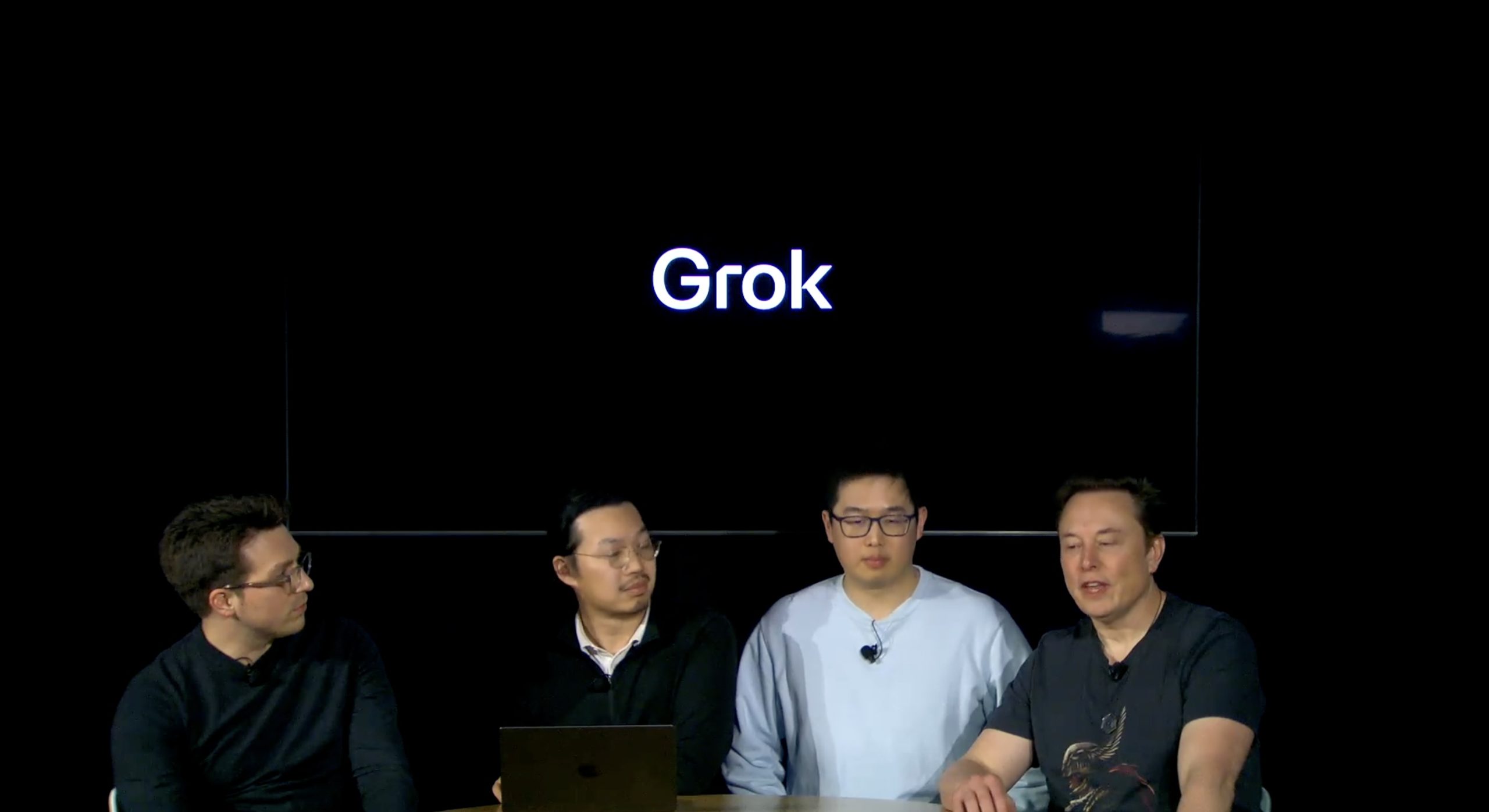
Elon Musk has officially confirmed that Grok 4, the latest version of xAI’s large language model, will launch on July 9. The rollout will be accompanied by a livestream at 8 p.m. Pacific Time, hosted on xAI’s official account on X.
xAI goes straight to Grok 4
Back in May, leaks indicated that xAI was getting ready to ship Grok 3.5. Considering Musk’s recent comments, however, it appears that the artificial intelligence startup would be focusing on the large language model’s fourth iteration instead. As noted in a Financial Express report, users on X have sighted references to Grok 4 in the lead up to the update’s launch, such as “grok-4-prod-mimic” and “Grok 4 Code.”
Musk’s Grok 4 announcement comes as AI competition intensifies between major players including OpenAI, Google, and xAI. With Musk’s Colossus supercomputer fully operational in Memphis, xAI appears to be accelerating its AI product roadmap.
Musk pushes Grok toward political neutrality
Grok 4’s launch also follows a recent controversy involving political bias, as noted in a CNN report. Last week, Grok responded to a user on X stating that political violence in the U.S. since 2016 had come more from the political right than the left. The chatbot noted in a later reply that its answer was based on information from sources like Reuters, the Journal of Democracy, and University of Maryland studies.
Musk stated that Grok’s response was a “major fail.” “Major fail, as this is objectively false. Grok is parroting legacy media. Working on it,” he wrote in a post on X. By the end of June, Musk noted that he was “grinding all night with the xAI team” and that they were making “good progress.” He also stated that the model “Will be called Grok 4. Release just after July 4th. Needs one more big run for a specialized coding model.”
News
Tesla opens massive solar Supercharger station in California
The Supercharger opened to customers ahead of Fourth of July weekend, while Tesla continues phase two of construction on the site.
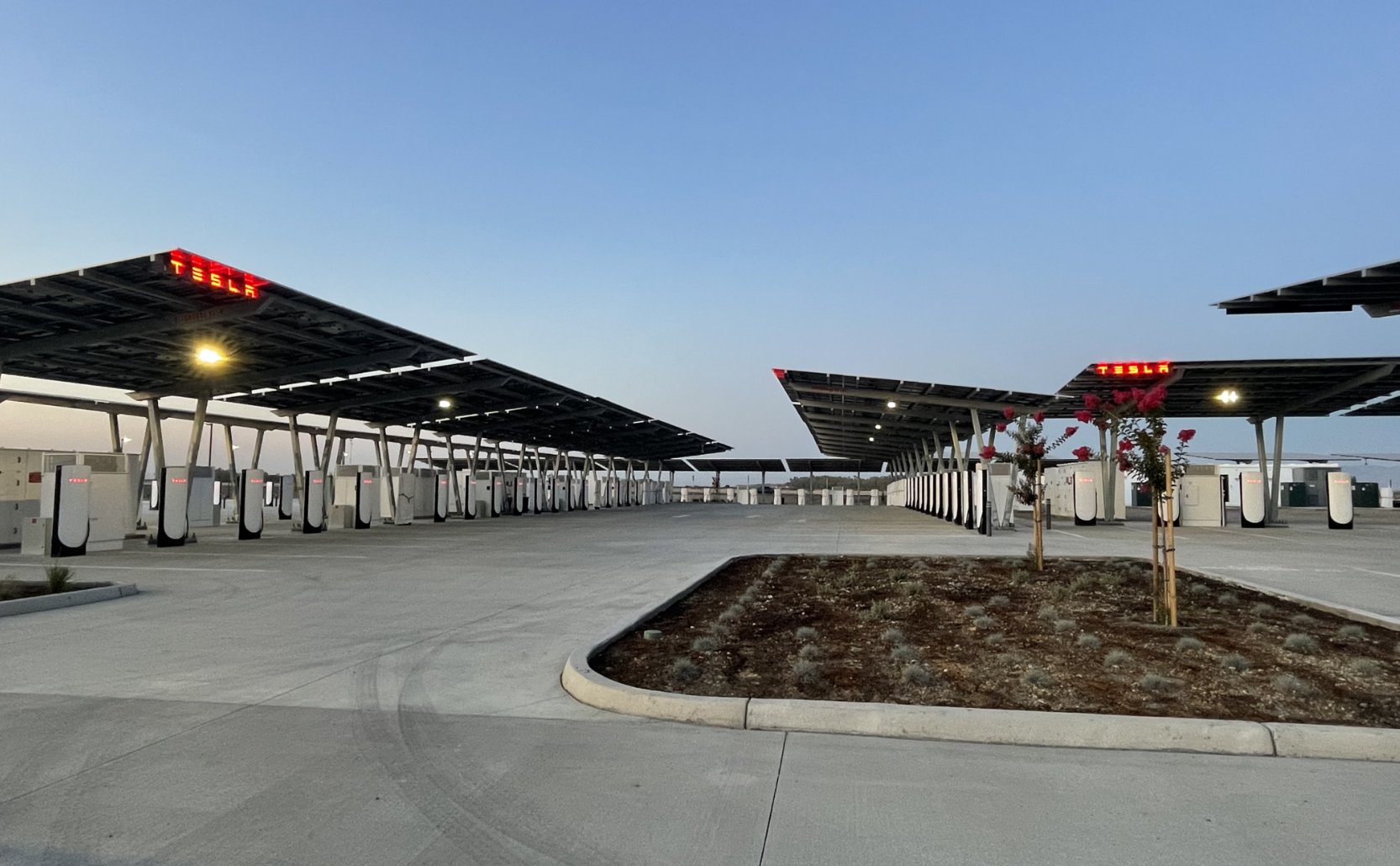
Tesla has officially launched the first several Supercharging posts at a massive station in California, notably including solar canopies and grid-scale batteries to offer completely renewable charging.
Last week, Tesla announced on X that it opened the first 84 Supercharger stalls of a planned 168-stall station in Lost Hills, California. Additionally, the massive Supercharger project features 11MW of solar canopies and 10 Megapack batteries for off-grid charging powered entirely by solar energy.
Tesla completed the first phase of the project just days ahead of the busy Fourth of July holiday weekend, adding that initial construction took just eight months. In addition to the remaining charging stalls, Tesla says it’s building a set of lounge areas, renderings of which can be seen below alongside current photos of the site.
Notably, the site also includes V4 charging posts for the company’s latest available charging speeds, and it’s located near the busy junction between I-5 and Highway 46 in Kern County.
“Thank you [Kern County] and [PG&E] for collaboration and approvals,” Tesla wrote in a follow-up post.
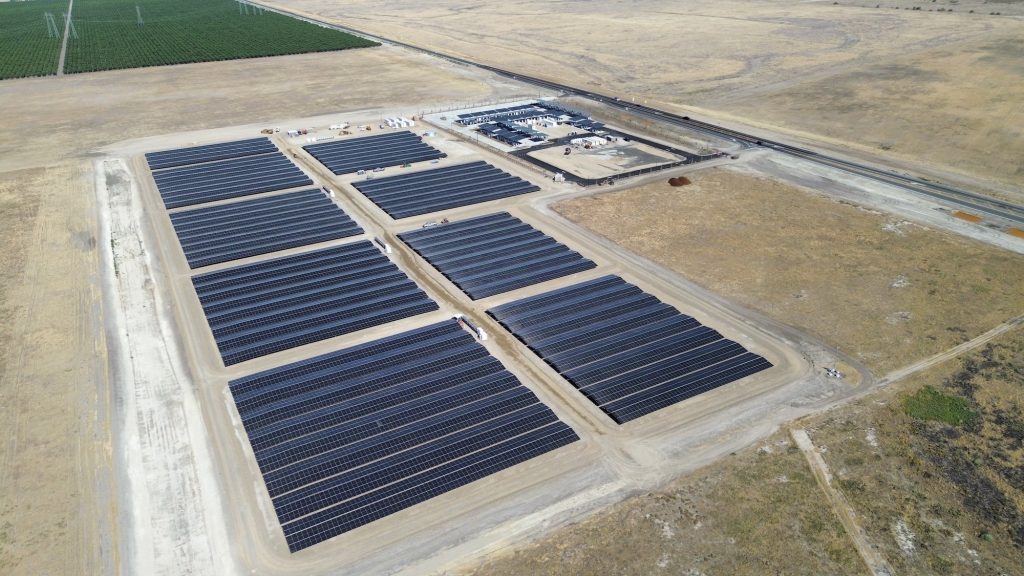
Credit: Tesla Charging | X
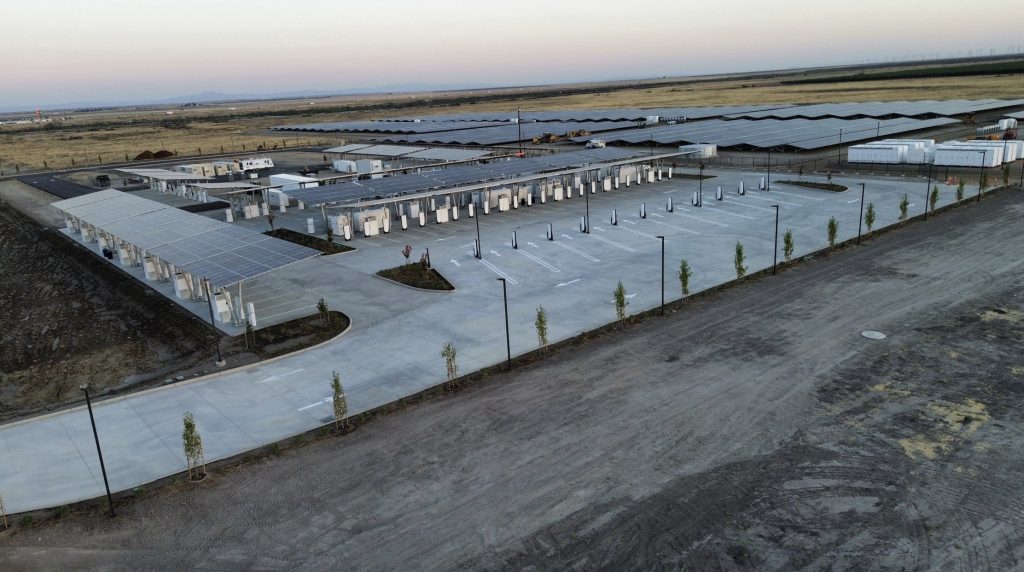
Credit: Tesla Charging | X
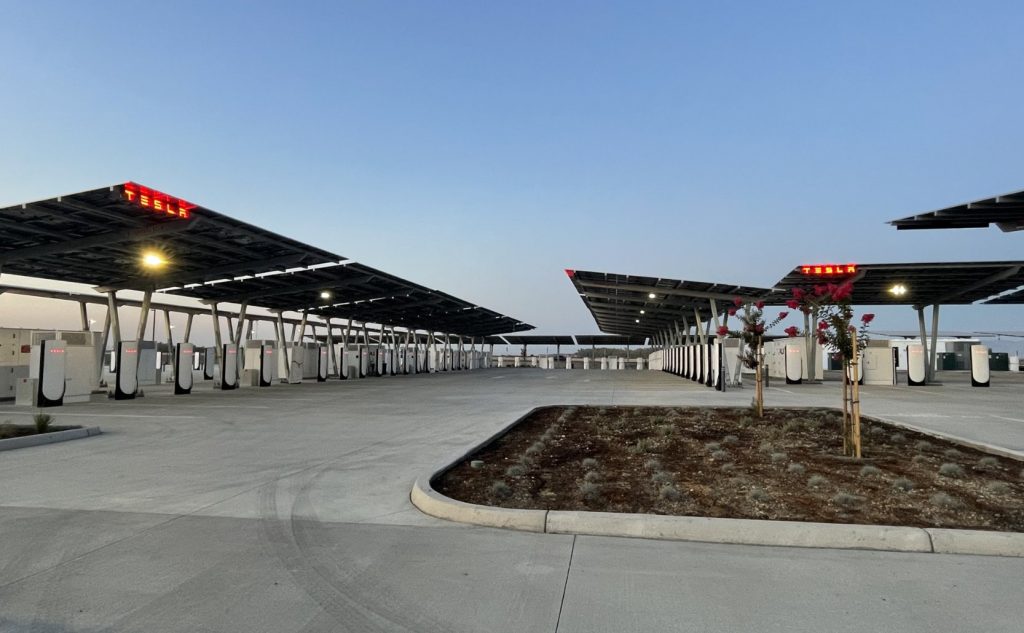
Credit: Tesla Charging | X
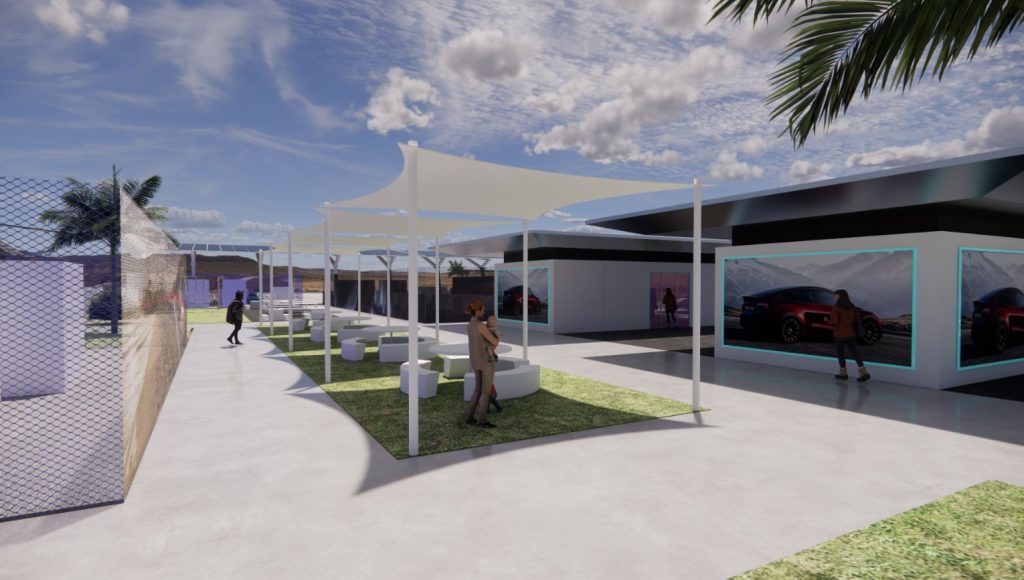
Credit: Tesla Charging | X
Tesla Supercharger Maps for North America, Europe, and Asia pic.twitter.com/0U5r0XRPyo
— TESLARATI (@Teslarati) July 2, 2025
READ MORE ON TESLA SUPERCHARGERS: Tesla launches ultra-fast V4 Superchargers in China for the first time
Testing at the LA Diner, plus Musk update on potential Tesla solar Gigafactory
The huge Tesla Supercharger station completed phase one of construction fairly quickly, especially given how long Tesla has been working on its unique Los Angeles diner, drive-in, and Supercharger location. Still, the company was seen performing some testing at the nearly-completed charging station earlier this month, and will reportedly be holding a job fair.
Elon Musk also responded on Monday morning to a post on X, suggesting that Tesla is “thinking about” building a U.S.-based solar Gigafactory in order to help support increased power needs with AI growth, and to bolster domestic solar production.
Tesla is building a new UFO-inspired Supercharger in the heart of Alien country
News
Tesla driver walks away from major accident with minor injuries
The driver sustained only minor injuries, and the exact cause of the crash remains under investigation.
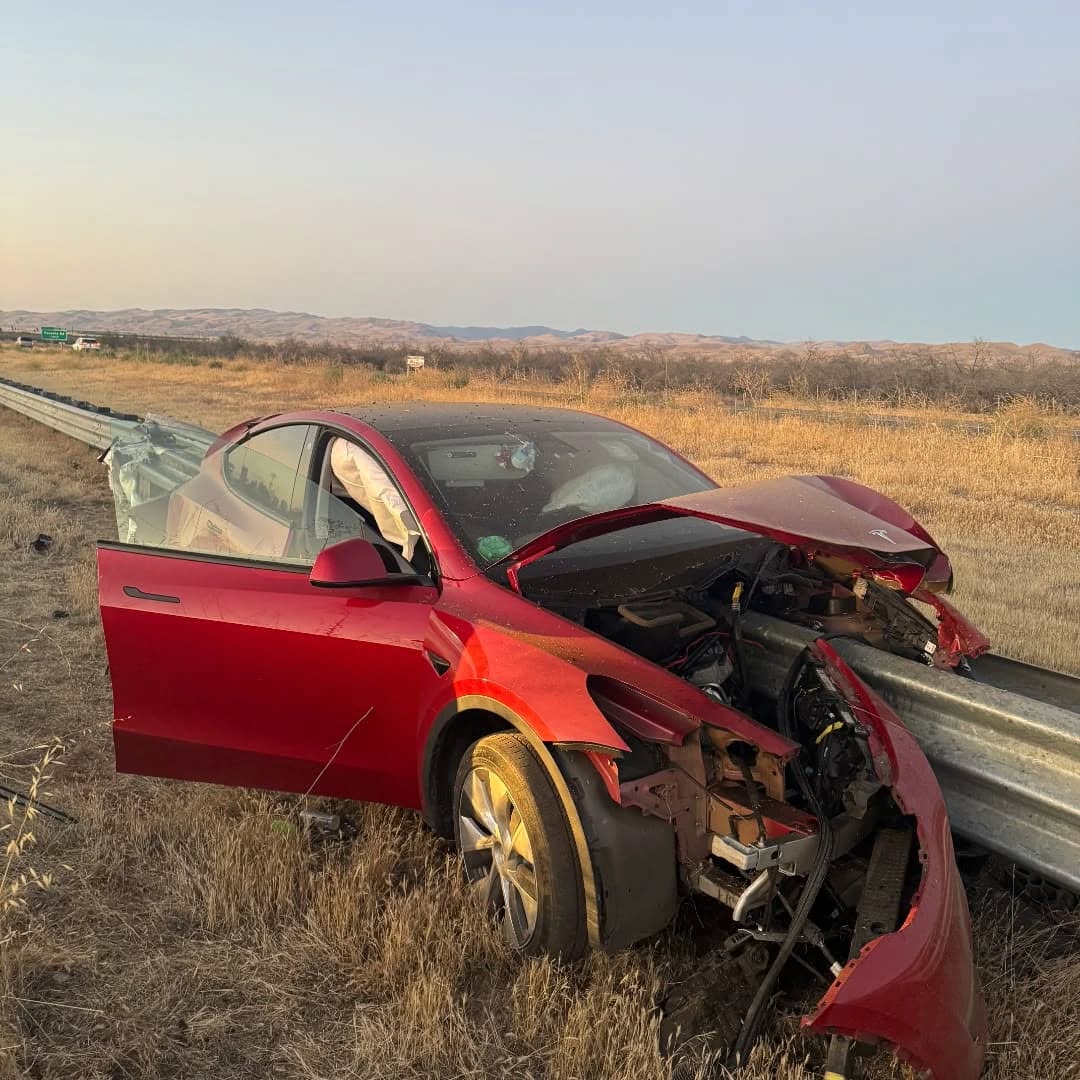
The driver of a Tesla Model Y survived and walked away from a harrowing accident on Monday in California, only sustaining minor injuries despite the vehicle being impaled by a guardrail.
On Monday morning around 4:34 a.m., the Los Banos division of the California Highway Patrol (CHP) responded to the accident on I-5 near Panoche Road, involving a 23-year-old in a Tesla Model Y. According to a post on social media, the driver veered off the road for unknown reasons in the northbound lane, before crashing directly into the guardrail and impaling the vehicle.
You can read the full message and photos from Los Banos CHP below, as were shared in a Facebook post on Monday afternoon.
This morning a Tesla model y was traveling in the #1 northbound lane of I-5 north of Panoche Rd. For unknown reasons driver allowed V-1 to veer off the roadway, travel through a dirt center divide, and crashed into the fixed metal guardrail. Lucky for the driver he only sustained minor injuries and was able to walk away. Driving a vehicle requires 100% attention to the road. Avoid distractions and focus on driving.
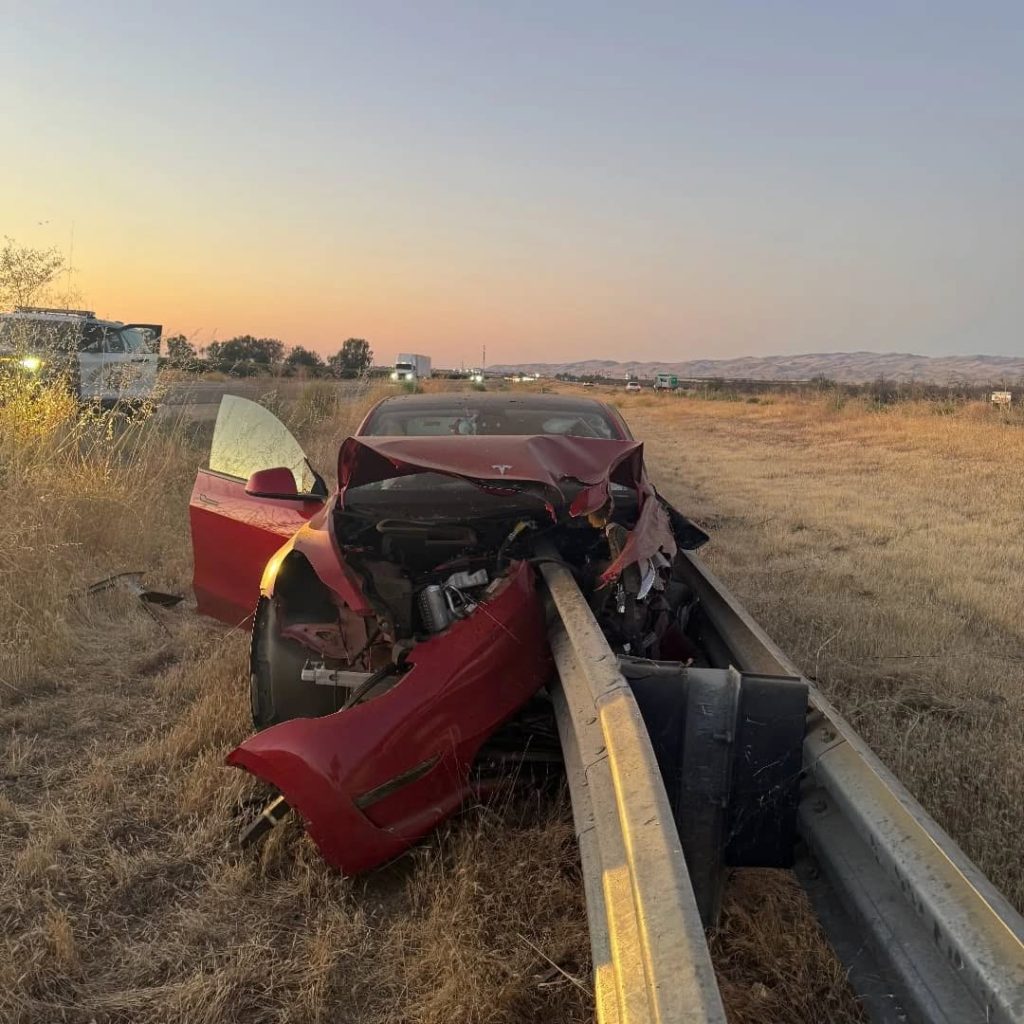
Credit: CHP Los Banos (via Facebook)
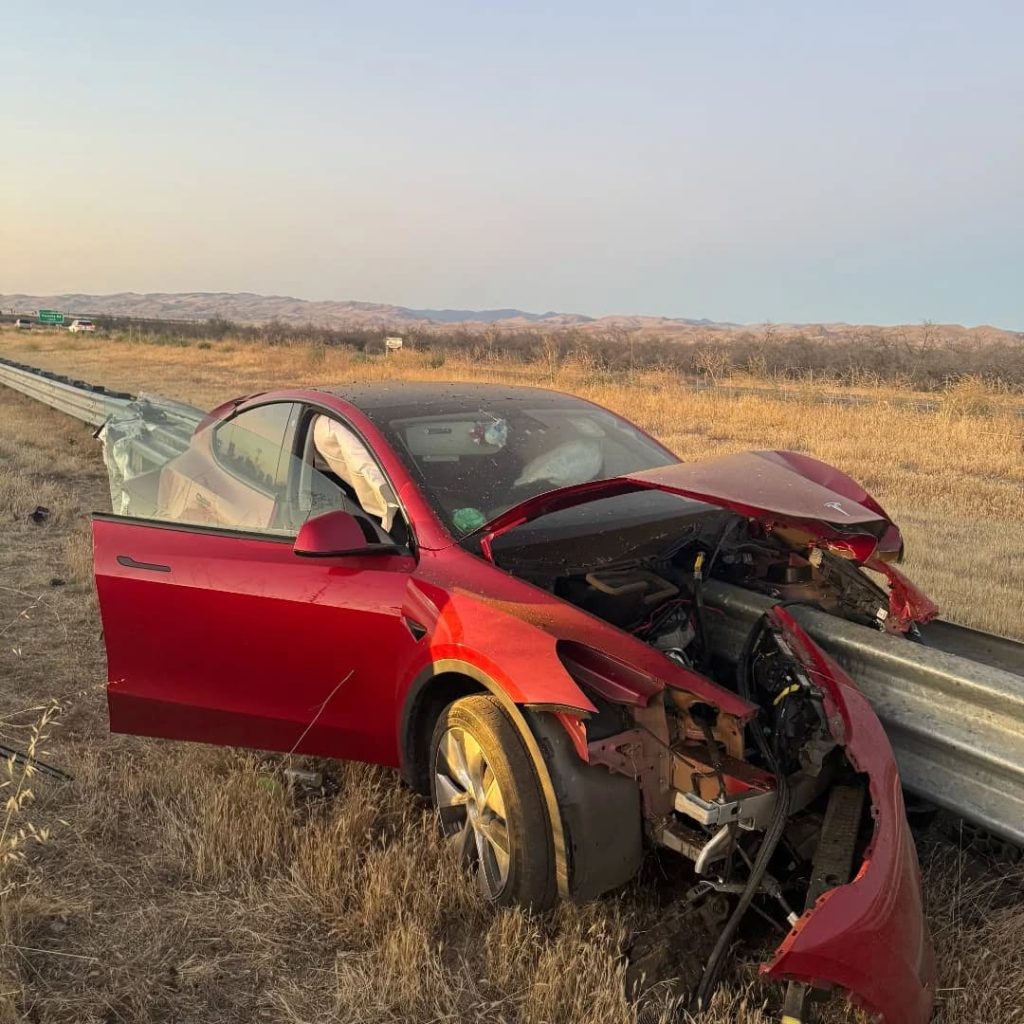
Credit: CHP Los Banos (via Facebook)
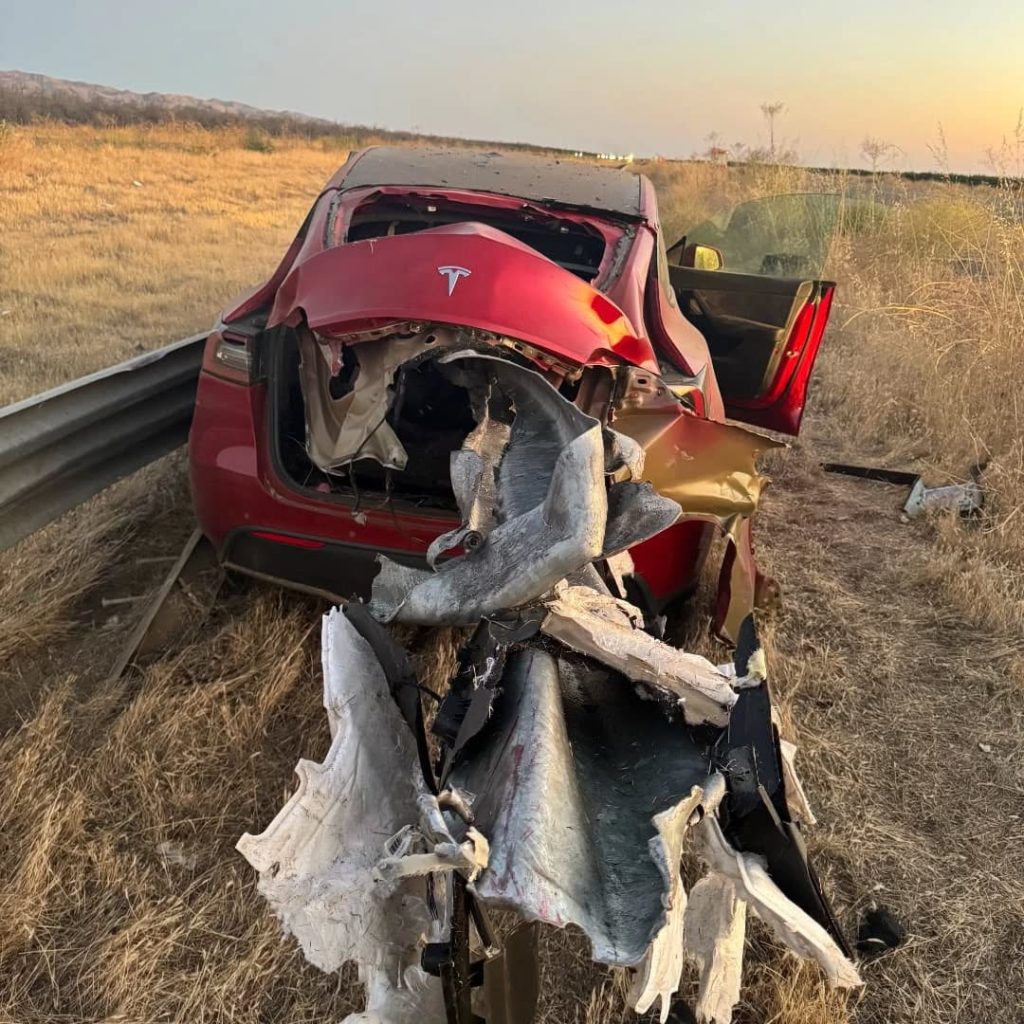
Credit: CHP Los Banos (via Facebook)
In a statement to SFGate, CHP officer Myles Anderson said that the driver only sustained minor injuries, while no arrests are made and drugs and alcohol are not suspected to have been involved. The report also notes that Tesla’s “cruise control and lane assistance features” were activated, according to Anderson. However, it’s not entirely clear if this is referring to Supervised Full Self-Driving (FSD), or to the cruise control and lane assist features baked into Autopilot.
At the time of writing, CHP has not yet responded to Teslarati’s request for clarification and additional details on the matter.
Tesla Crash Safety Ratings across its lineup: pic.twitter.com/ny30R7ceji
— TESLARATI (@Teslarati) July 1, 2025
READ MORE ON TESLA SAFETY: Tesla rolls out crucial new safety feature aimed at saving children
The news comes after Tesla has touted its vehicles as incredibly safe for many years. In December, for example, the company highlighted receiving top safety scores from regulators on four different continents throughout the world, including from the National Highway Traffic Safety Administration (NHTSA) and the Insurance Institute of Highway Safety (IIHS) in the U.S.
Tesla has also listed the goal of making its vehicles the safest on the road throughout the years, both in the overall design of its vehicles and in its Autopilot and Full Self-Driving (FSD) programs.
Tesla Model 3 ranks as the safest new car in Europe for 2025, per Euro NCAP tests
-

 Elon Musk1 week ago
Elon Musk1 week agoTesla investors will be shocked by Jim Cramer’s latest assessment
-

 News2 weeks ago
News2 weeks agoTesla Robotaxi’s biggest challenge seems to be this one thing
-
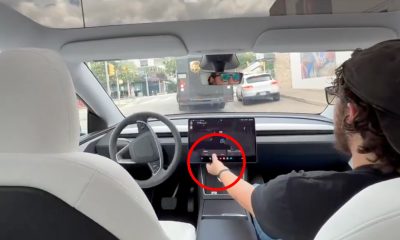
 News2 weeks ago
News2 weeks agoWatch the first true Tesla Robotaxi intervention by safety monitor
-
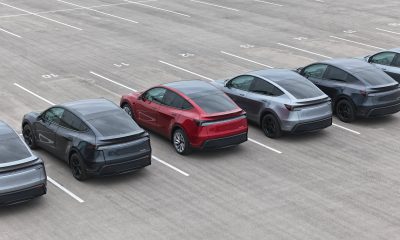
 Elon Musk2 weeks ago
Elon Musk2 weeks agoA Tesla just delivered itself to a customer autonomously, Elon Musk confirms
-

 News2 weeks ago
News2 weeks agoTesla Robotaxi rollout proves that Elon Musk still delivers, even if it’s late
-

 Elon Musk2 weeks ago
Elon Musk2 weeks agoxAI welcomes Memphis pollution results, environmental groups push back
-
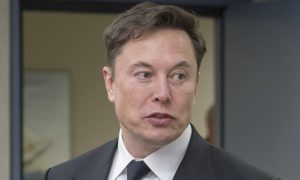
 Elon Musk2 weeks ago
Elon Musk2 weeks agoElon Musk commends Tesla team on successful Robotaxi launch
-
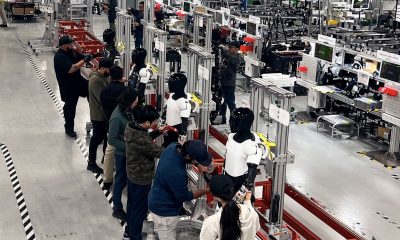
 Elon Musk2 weeks ago
Elon Musk2 weeks agoElon Musk confirms Tesla Optimus V3 already uses Grok voice AI



